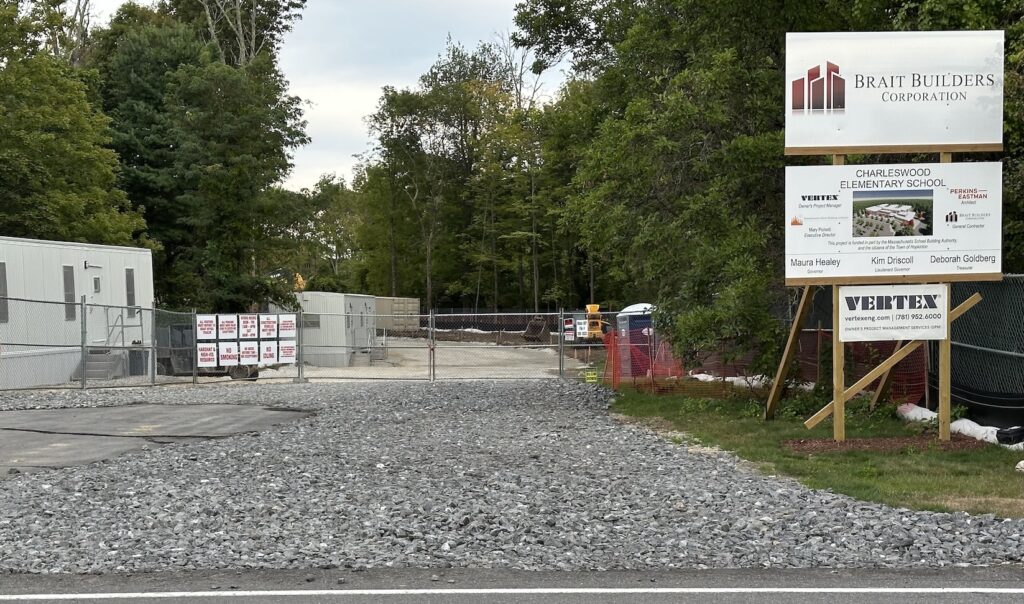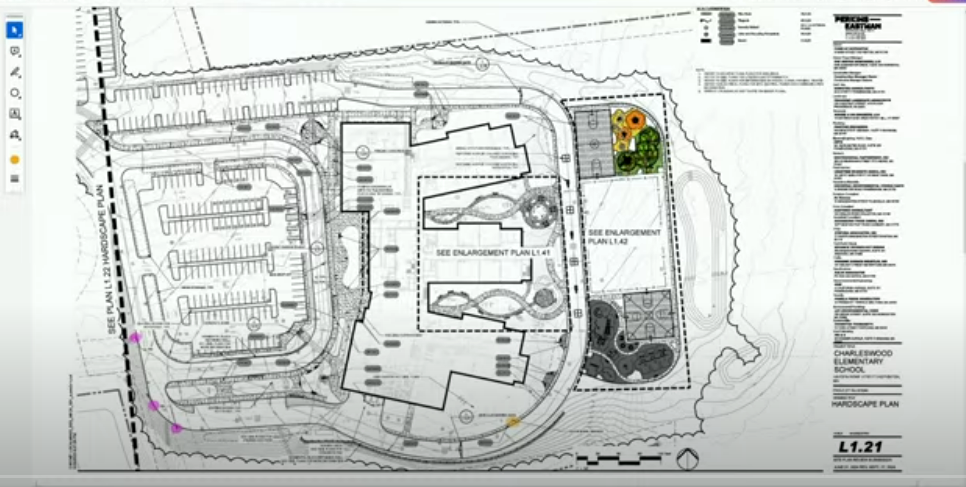The importance of the review process and implications of a ‘no’ vote on the proposed Elmwood School replacement building were among the issues discussed during Wednesday’s Elementary School Building Committee meeting.
Chris Eberly, senior project manager at Vertex, explained all the work during the schematic design phase (representing 30% of the project) is meant to identify a budget that can fund the facility’s design and construction.
Still ahead is the design development phase, estimated to take seven months, followed significantly, Eberly said, by “an approval process to meet the community standards set for what a project in Hopkinton should be.”
Approval process has many steps
The project must go before the Conservation Commission, Planning Board and Design Review Board, and matters of water and sewer, stormwater and traffic must be reviewed.
State reviews are required by the Historic Commission (completed), Massachusetts Environmental Policy Act and Massachusetts School Building Authority.
Eberly noted the Planning Board aspect has multiple steps, including third-party reviews, abutter notifications, public hearings, designer responses and resubmissions.
The Town Meeting vote on Nov. 13 “is not to build the building that is before you,” Eberly said. “The vote is to set a budget that will reach the building that the town ultimately wants to build.”
“That budget is the budget,” said chair Jon Graziano. “It’s the ceiling. We are not spending above that.”
For example, Eberly noted some of the street improvements may not go forward, thereby spending less. Or, the town may decide to mitigate stormwater issues at a higher level and direct funds that way.
In all cases, contingencies are in place within the budget of $158 million to cover such decisions as the project gets reviewed.
He said the degree to which contingency funds are used during projects varies and is based on “the appetite of the town’s Building Committee to spend it.”
Graziano said all items must come before the ESBC before any contingency money is spent.
Eberly noted a project in Millis did not use as much contingency money as expected, whereas other communities may spend the maximum.
ESBC member Mike Shepard said the importance of the Planning Board during the process cannot be overlooked.
“The important takeaway is after Town Meeting,” Shepard said. “The residents will still have the opportunity at the Planning Board to make their desires known and the Planning Board, all voting members of the town, will take that [input] into consideration.”
Graziano reviewed a list of questions largely about traffic submitted by residents. Several inquiries were examples of things that would be handled by town boards such as timing and frequency of traffic signals, sewer tie-ins, road sign placement, light pollution to neighbors, etc.
Eberly pointed out a traffic light was proposed for the Marathon School addition project and the Planning Board rejected it, citing 600 students as too few to qualify. The proposed new Elmwood School is seeking to accommodate twice that number.
On a related note, Eberly reported that because of an MSBA clerical error, the amount of reimbursement for the Elmwood replacement project increased to $46,784,822.
What does ‘no’ vote entail?
ESBC member Bill Flannery, who is on the Appropriations Committee, said there is a perception that if Town Meeting votes no, “the district will add a few modulars and be done,” which is not the case. He said the committee must proactively talk about a system-wide study that shows how enrollment growth impacts each building.
School Committee vice chair Amanda Fargiano said Elmwood is an “end of life” project. Significant infrastructure investments would have to be made to the existing school to make it “a healthy place to learn.”
Eberly said there is recent historical data to show how much modulars and additions cost. At Marathon, the town spent $5.1 million to add four classrooms; two classrooms each at Hopkins and Elmwood cost $1.9 million and $2.4 million, he said.
Other factors include class sizes rising, the need for additional lunches and a gym, he said. “Answering those questions is not a scare tactic, but it’s an analysis of what the implications of growth means to how you educate your students in Hopkinton and what you’ll need to deal with growth already occurring,” Eberly said.
He noted that in some cases, current enrollment numbers have exceeded the reconciled estimates done by two demographers to forecast enrollment growth.
ESBC member Jagrut Jathal agreed details like these should be disseminated to the voters before Town Meeting.
“With a ‘yes’ vote there is a lot of information of what happens next based on the work of the committee, but not much on the ‘no’ side. It should be just as available,” Jathal said.
Traffic benefits weighed
Eberly outlined benefits of the proposed traffic plan and the impact of having a connected campus between Marathon and the proposed new school.
Advantages, he said, include the proposed configuration frees up 12 buses, adding more routes and shortening bus rides; consolidation of stops eliminates the need for two buses to travel the same route through neighborhoods and reduces the number of stops by 200, or 28%.
The new car queue at the proposed school accommodates 85 cars and 18 buses, pulling traffic off Hayden Rowe Street. Future conditions have all elementary buses enter Marathon Drive and drop students off and avoids bus crossing at Hayden Rowe Street.
By freeing up and increasing the fleet, Assistant Superintendent Susan Rothermich said the district could reduce mileage.
Superintendent Carol Cavanaugh explained Elmwood School has its own fleet, while Hopkins and Marathon share buses.
“If Elmwood moves, then all those buses can be put to different use,” she said. “Currently, all those buses are driving around following each other. Having two buses with one route for each is a terrible waste of resources.”
Graziano pointed out the traffic consultant’s study indicated it is not the volume of traffic on the road at drop-off and pickup times, but rather the left turn that stops traffic and backs things up.
Some 60% of Elmwood students have siblings elsewhere in the district, which means parents must drive to multiple schools and cross Hayden Rowe.
Former Elmwood Principal Anne Carver said it is stressful for parents to rush around to collect kids at different sites, and sometimes they are late and “teary.”
Shepard noted the situation impacts teachers by creating extra work as they oversee kids at bus runs.
“I see three or four teachers at pickup,” he said, “when they should be correcting homework and doing teacher stuff.”
Shepard said his four grandchildren all attend different schools, and his daughter-in-law was driving them in and out, a hectic situation. This year, the kids all are riding buses.
Public forums scheduled
The ESBC announced public forums on Oct. 24 and Nov. 7, both at the high school but with a Zoom option available. The forums start at 7 p.m.



















The consultant’s comment that commuter traffic is at a different time than school traffic seems absurd to all I’ve mentioned it to. This is particularly true given the work on the 495/Mass Pike that will force traffic to Hayden Rowe, and even after that work is done, any accident on 495 will increase traffic.
I still haven’t heard why we can’t think outside the box and use available commercial buildings. If it costs $70M to use these buildings but the state won’t reimburse funds, that’s still cheaper than the roughly $110M it will cost us after state reimbursement, never mind that those state funds are our taxpayer money as well.
Is 3 stories a good fit for young children?